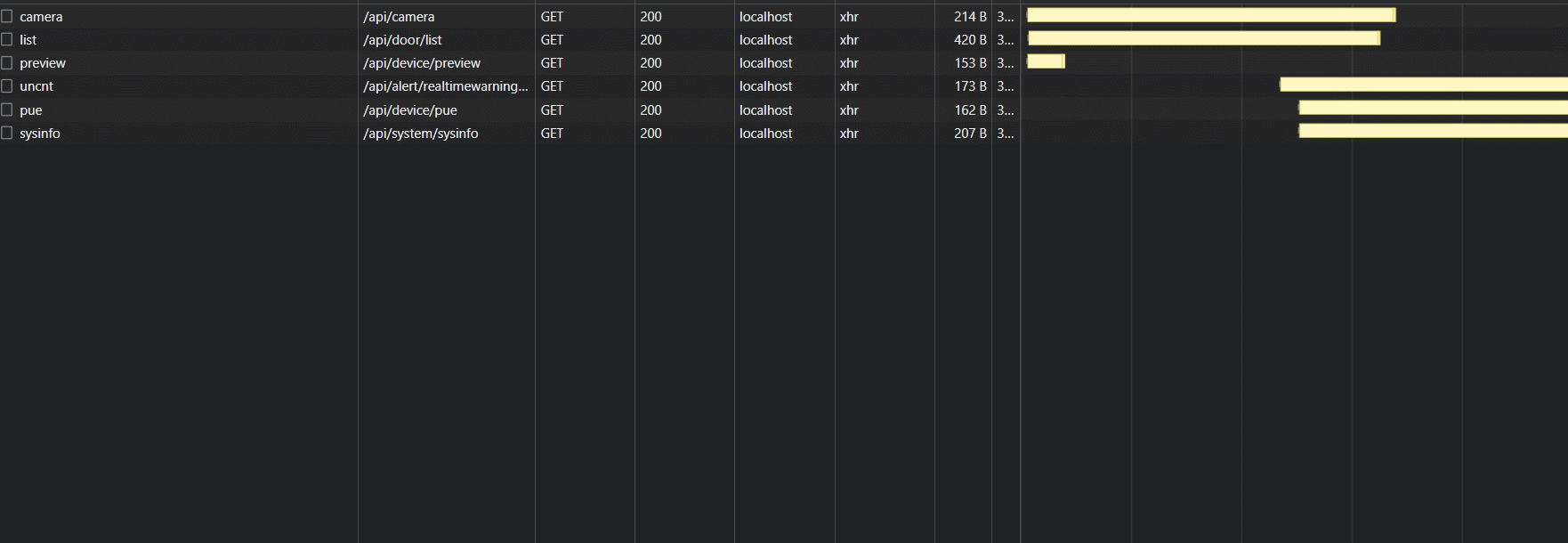
vue 如何依次请求 20 多个 axios 请求,同步请求多个,按次序请求
有一个人员列表, ,每个人员都有多张卡片 + 多个指纹数据因为我们用的是 ,它是异步的,返回每个请求的对象,而我们需要的是同步功能,就是同一时间,只有一个请求在执行。执行完上面的请求之后,再执行下面的请求。需要使用ES6的基本的用法是:带的方法内,使用来同步执行返回的方法,例:对比上面的请求,下面这种请求的结果返回顺序是不可控的三、具体实现方法其请求过程是这样的:.................
vue 如何依次请求 20 多个 axios 请求,同步请求多个,按次序请求
什么是同步,什么是异步
反正挺绕,我一直默认理解的是同步就是多个线程同时请求,在软件开发中实则不是这么理解的。
同步是单线程,同一时间只有一个请求
异步是多线程,就是多个请求异步执行,会有多个请求同时进行
异步的时候是这样的,多个请求同时触发,每个请求的结束时间不确定。

一、需求
有一个人员列表, userListData,每个人员都有多张卡片 + 多个指纹数据
- 将人员列表中的所有人员的所有卡片+指纹数据都展示出来。
- 后台因某种条件限制,只提供查询单个人员卡片、单个人员指纹数据的接口。
- 且后台不能一次性接收多个请求,不然会卡死,能保证的是 300ms 内处理两个请求是没有问题的。
二、如何实现
因为我们用的是 axios,它是异步的,返回每个请求的 promise 对象,而我们需要的是同步功能,就是同一时间,只有一个请求在执行。执行完上面的请求之后,再执行下面的请求。
需要使用 ES6 的 async await
具体使用方法可以看这里:
https://blog.csdn.net/weixin_44972441/article/details/124785718
基本的用法是:
带 async 的方法内,使用 await 来同步执行返回 promise 的方法,例:
methods: {
async getAllUserInfo(){
let user1Info = await getUserInfoOf(1)
let user2Info = await getUserInfoOf(2)
console.log(user1Info, user2Info)
}
}
对比上面的请求,下面这种请求的结果返回顺序是不可控的
methods: {
getAllUserInfo(){
getUserInfoOf(1)
.then(res => {
console.log(user1Info)
})
getUserInfoOf(2)
.then(res => {
console.log(user2Info)
})
}
}
三、具体实现方法
作一个循环请求用户数据的方法,循环在这个方法内调用自己这个方法,入口处作判断,满足条件:用户已经遍历完成,就结束。
data(){
return {
// 用户数据列表
userListData: [
// { id: 1, treeId, user2, label: '华强' ] }
],
// 循环请求用户数据时的 标记 index
loopIndex: 0,
}
},
methods: {
treeCheckAll(){
this.getAllUserInfoWithNoUpdate()
},
// 只获取人员数据,不改变其它
getAllUserInfoWithNoUpdate(){
let loadingOption = {
lock: true,
text: "正在请求所有用户数据,请耐心等待,不要离开该页面...",
background: "rgba(0, 0, 0, 0.7)"
}
this.loopIndex = 0
this.layerLoadingAllUser = Loading.service(loadingOption)
this.getUserInfoSync()
},
// 连续依次获取所有用户信息
async getUserInfoSync(){
// 每次执行之前,判断是否已经遍历所有用户,如果已经遍历所有用户,执行结束
if (this.loopIndex < this.userListData.length){
let currentUser = this.userListData[this.loopIndex]
// 获取卡片信息
let res = await doorApi.cardList({
doorId: this.doorId,
employeeNo: currentUser.id
}, this.cancelTokenSource.token)
// 加了 await 的方法,它会依次往下执行,不会像原始 axios 那样需要回调方法一样的使用
if (res && res.length > 0){
currentUser.cards = res
} else {
currentUser.cards = []
}
// 获取指纹信息
let res = await doorApi.fingerprintList({
doorId: this.doorId,
employeeNo: currentUser.id
}, this.cancelTokenSource.token)
// 加了 await 的方法,它会依次往下执行,不会像原始 axios 那样需要回调方法一样的使用
if (res && res.length > 0){
currentUser.fingerprints = res.map(item => item.fingerPrintID)
} else {
currentUser.fingerprints = []
}
this.loopIndex = this.loopIndex + 1
// 每 300ms 执行一下此方法
setTimeout(this.getUserInfoSync, 300)
} else {
// 连续请求结束后的操作
// do something
}
},
}
其请求过程是这样的:

四、使用递归
还有一种方法使用递归。
比如,我有一个数组 wordsChunks = [ [words], [words]]
我需要将这个数组中的每个数组都上传到服务器。
可以定义几个变量:
currentChunkIndex: 0, // 当前分组 index,批量上传用
wordsChunks: [[word, word,word], [word,word,word]], // 词条分组
addNewWords(wordsChunk){
wubiApi
.word
.addBatch({
category_id: this.formBatch.category_id,
words: wordsChunk[this.currentChunkIndex]
})
.then(res => {
this.countExisted += res.data.existCount
this.countAdded += res.data.addedCount
this.currentChunkIndex++
// 以 currentChunkIndex 的值为判断,当大于 分组数时,停止上传
if (this.currentChunkIndex < this.wordsChunks.length){
this.addNewWords(this.wordsChunks) // 自己调用自己
} else {
this.addNewWordsFinished()
}
})
},

最终的结果如下:

更多推荐
 已为社区贡献2条内容
已为社区贡献2条内容








所有评论(0)